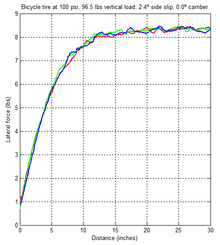Relaxation length
Relaxation length is a property of pneumatic tires that describes the delay between when a slip angle is introduced and when the cornering force reaches its steady-state value.[1] It is also described as the distance that a tire rolls before the lateral force builds up to 63% of its steady-state value.[2] It can be calculated as the ratio of cornering stiffness over the lateral stiffness, where cornering stiffness is the ratio of cornering force over slip angle, and lateral stiffness is the ratio of lateral force over lateral displacement.[1]

Values
Pacejka gives a rule of thumb that "at nominal vertical load the relaxation length is of the order of magnitude of the wheel radius".[1] Relaxations lengths have been found to be between 0.12 and 0.45 meters, with higher values corresponding to higher velocities and heavier loads.[2] Tests on motorcycle tires have found that the ratio of cornering stiffness over lateral stiffness produces values 20-25% higher than those calculated as 63% of the steady state-value.[3] The relaxation length associated with camber thrust has been found to be nearly zero.[2]
Importance
A tire's relaxation length controls how much the tire will contribute to speed wobble.[4]
References
- Pacejka, Hans B. (2006). Tyre and vehicle dynamics (2nd ed.). SAE International. p. 22. ISBN 978-0-7680-1702-1.
The relaxation length ... is an important parameter that controls the lag of the response of the side force to the input slip angle.
- Cossalter, Vittore (2006). Motorcycle Dynamics (Second ed.). Lulu.com. p. 58. ISBN 978-1-4303-0861-4.
The relaxation length represents the distance the wheel has to cover in order for the lateral force to reach 63% of the steady state force.
- R.T. Uil (June 2006). "Non-lagging effect of motorcycle tyres: An experimental study with the Flat Plank Tyre Tester" (PDF). Eindhoven University of Technology, Department of Mechanical Engineering. p. 14. Retrieved 2010-10-31.
For the relaxation behaviour of motorcycle tyres, it can be concluded that the relaxation length for side slip defined by Pacejka is higher than the relaxation length determined from the steady-state side force.
- Peter Willem Anton Zegelaar (March 1998). "The Dynamic Response of Tyres to Brake Torque Variations and Road Unevennesses" (PDF). Delft University of Technology. p. 16. Archived from the original (PDF) on 2013-10-04. Retrieved 2013-10-02.
the relaxation length plays an important role in the ‘shimmy’ phenomenon.